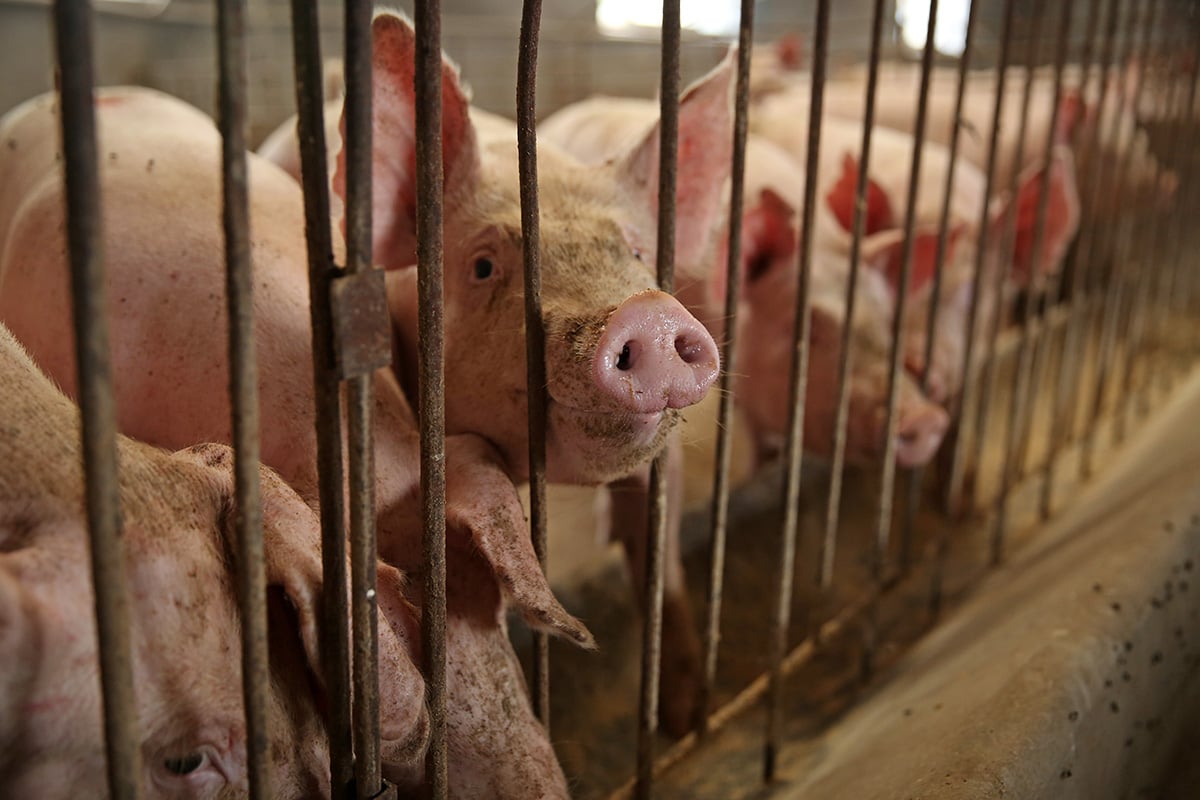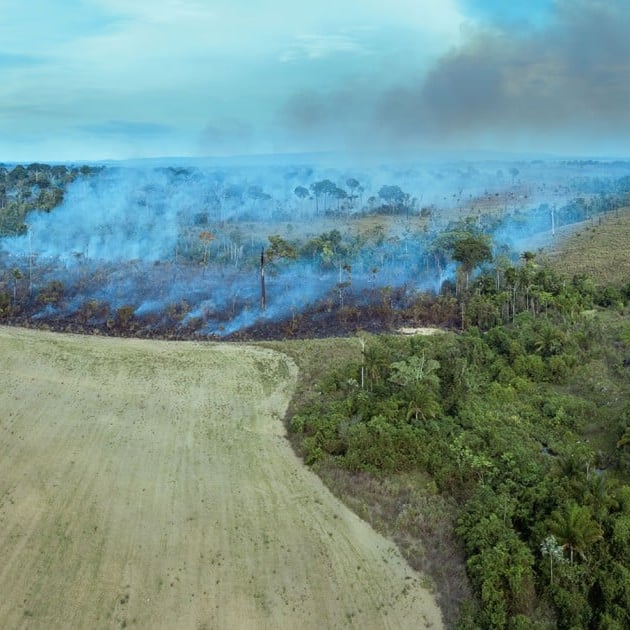Governments must uphold the commitments made within the Emirates Declaration to cut back manufacturing unit farming emissions – defending our local weather and wildlife habitats, and saving billions of farmed animals from a lifetime of struggling.
In November 2023, 160 nations agreed to the Emirates Declaration on Sustainable Agriculture, a groundbreaking initiative from COP28 that centered on altering agriculture and meals methods to unravel local weather change. They pledged to place ahead formidable local weather targets and targets – however little progress has been made.
As COP29, we urged them to make good on their dedication and act to finish manufacturing unit farming.
The devastating impacts of manufacturing unit farming
With the most important meat and dairy corporations’ local weather influence outweighing that of a number of developed nations, there’s no greater risk to the way forward for our planet than the enlargement of manufacturing unit farming.
Regardless of this, manufacturing unit farming is nearly all the time neglected because the local weather perpetrator throughout the agriculture sector. But it’s manufacturing unit farming that rips down forests to plant crops for animal feed – releasing carbon into the ambiance. And it’s manufacturing unit farming that devastates wildlife habitats, displaces native communities and earnings from the merciless remedy of billions of farmed animals annually.
Impacts on the setting
Manufacturing unit farming contributes no less than 11% of the worldwide greenhouse gases fuelling local weather change.
Fossil fuels are used to supply fertilisers for factory-farmed animal feed. And when utilized to fields, these fertilisers launch dangerous nitrous oxide greenhouse gases into the ambiance. Total, greenhouse gases from manufacturing unit farm pig and meat rooster feed manufacturing and processing are equal to protecting 104 million vehicles on the highway for a yr.
And this footprint is about to develop. Demand for meat is rising quick, paving the best way for the additional enlargement of manufacturing unit farming. Again in 1970, world beef manufacturing was roughly the identical as that of rooster and pork mixed. With the expansion in manufacturing unit farming, probably the most intensively farmed species – rooster and pork – are anticipated to be produced at ranges triple that of beef by 2050.
Impacts on factory-farmed animals
Not solely does a larger demand for meat imply a larger local weather influence, but it surely means billions extra farmed animals condemned to lives of struggling.
Proper now, yearly greater than 80 billion animals are farmed, most condemned to manufacturing unit farms the place their lives are temporary and stuffed with struggling.
On manufacturing unit farms, animals are squashed collectively, typically stored in cages and painfully mutilated. Farmed chickens exist squashed in opposition to tens of hundreds of different chickens, with no room to flap their wings or perch like they might naturally.
A mom pig lives her life in a cage, unable to show round, typically biting the metal bars round her in frustration, inflicting accidents. Her piglets are stripped from her as early as 21 days previous, their tails and enamel are minimize and males are castrated.
To deal with merciless situations and stop them from getting sick, animals are dosed day by day with antibiotics of their feed or water. That’s a dangerous follow, creating the perfect setting for superbugs to emerge and switch to people through the meals chain or the environment.

Huge companies are failing
Huge manufacturing unit farming companies are doing their greatest to cowl over their cracks with a speedy enhance within the variety of ‘carbon impartial’ commitments. This consists of promising to cut back emissions depth of business-as-usual practices through technological breakthroughs, like altering feed formulations for animals. However minor tweaks to cut back emissions received’t be sufficient whereas general meat manufacturing continues to develop sharply.
There isn’t any getting across the inherent carbon-intensive nature of manufacturing unit farming, together with its dependence on the worldwide animal feed commerce.
Greenwashing is rife
Companies are additionally shopping for their means out of their obligations by calculating their local weather impacts and paying to ‘offset’ the injury through schemes that take away carbon from the ambiance, similar to tree planting. That is nothing wanting greenwashing, and the last word irony is that by locking land into crop manufacturing for feeding factory-farmed animals, there’s little land left to reforest.
It’s clear that manufacturing unit farming is successful whereas our local weather and wildlife suffers. Farmed poultry now makes up 71% of all fowl species by mass, whereas wild birds make up simply 29% of whole fowl species by mass4.
Options to deal with local weather change and animal cruelty
Analysis commissioned by World Animal Safety is the world’s first examine to measure the potential local weather and environmental advantages of consuming much less factory-farmed rooster and pork, whereas concurrently ending the cruellest practices on manufacturing unit farms and enhancing dwelling situations for the billions of animals at the moment trapped inside them.
Our analysis revealed the three greatest methods to guard animals and combat local weather change…
Eat much less and higher meat
Will increase in general meat consumption within the coming a long time will exacerbate the local weather impacts of manufacturing unit farming.
Researchers measured the influence of diets containing much less rooster and pork, in addition to eventualities when folks ‘eat much less and higher’, that means they not solely eat much less rooster and pork, in addition they select larger welfare meat once they do.
They discover {that a} 50% discount in consumption of each rooster and pork by 2040, together with a 50% adoption of upper welfare merchandise would halve the annual local weather impacts of rooster and pork manufacturing throughout these 4 sizzling spots. This is able to be equal to taking 45 million vehicles off the highway for a yr within the 4 sizzling spots mixed.
Finish merciless manufacturing unit farm practices
The analysis additionally finds that there isn’t a vital distinction between the local weather impacts of standard manufacturing unit farming and better welfare manufacturing unit farming the place pigs are not stored in cages, meat chickens have extra room to maneuver, animals aren’t mutilated, and better welfare breeds of animals are used to make sure they develop at a fee that doesn’t impose painful well being issues on them.
This implies there isn’t a excuse for the business to keep away from ending the cruellest practices for animals that stay on manufacturing unit farms.
Ban new manufacturing unit farms
One of the simplest ways to guard animals and deal with local weather change is to finish manufacturing unit farming, beginning with a ban on new manufacturing unit farms. Substantial reductions in meat manufacturing and consumption will assist to break manufacturing unit farming financially and unlock the humane and sustainable future we’d like.
Manufacturing unit farming isn’t a precondition for meals safety – it undermines it. Though our analysis focuses on particular manufacturing unit farming sizzling spots, the worldwide message is obvious – we have to rethink the present drive to construct extra manufacturing unit farms in components of the world the place demand for meat is rising most sharply. Extra manufacturing unit farms would take a heavy toll on our local weather whereas condemning billions extra animals to lives of struggling.
At #COP29, @WrldFed4Animals launched the #Animals4Climate Motion instrument, highlighting how biodiversity safety and animal welfare can minimize emissions and improve local weather resilience.
Policymakers now have steering to incorporate animals in local weather plans. https://t.co/ioUaURZqpp
— World Animal Safety (@MoveTheWorld) November 19, 2024
It’s time for motion
If policymakers are to make good on their pledge to cut back the colossal local weather footprint of meals methods, local weather talks must give attention to manufacturing unit farming and agriculture.
The most important manufacturing unit farming corporations proceed their stranglehold on our meals system off the again of misguided authorities insurance policies that confuse manufacturing unit farming with meals safety.
However the huge volumes of meat, delivered at low cost costs by manufacturing unit farming, relaxation on a paradox. Meals safety is undermined as land is diverted to develop crops to feed animals relatively than people. In 50 years, soy manufacturing has grown at double the speed of human inhabitants enhance. Greater than three-quarters (77%) of world soy is now fed to farmed animals, not used for human meals. Native farmers are caught up in a profit-driven world commerce in commodity crops for manufacturing unit farms, that means native communities go hungry.
Manufacturing unit farming worsens local weather change, and local weather impacts are felt disproportionately by small farmers. Adversarial climate causes their crops to fail or their livestock to succumb to illness. Wild animals endure agonising deaths from droughts, floods and fires at larger frequency and severity. Animals are much less resilient to illness and habitat destruction from animal feed enlargement, rising the danger of illness spillover from animals to people. There’s a robust threat that intensive agriculture might set off the subsequent pandemic.
What can governments do?
Little progress has been made to remodel the worldwide meals system and a elementary change remains to be wanted for the sake of our local weather and our planet. Governments shouldn’t be sticking their heads within the sand prior yearly at COP.
They need to:
- Publicly recognise that industrial animal agriculture is a serious contributor to local weather change and take steps to forestall deforestation linked to animal feed, meat and dairy manufacturing, together with imports.
- Decide to reject plans for additional manufacturing unit farms and droop the enlargement of current farms.
- Introduce and implement minimal farmed animal welfare requirements (FARMS), to finish the worst types of struggling on remaining manufacturing unit farms.
- Guarantee authorities rules make manufacturing unit farming redress its many harms – to local weather, the setting and our well being.
- Change subsidies and incentives so that they assist a predominantly plant-based meals system, and towards equitable, humane and sustainable types of meals manufacturing, prioritising environmental well being, animal welfare and social fairness.
- Decide to halving animal meat manufacturing and consumption by 2040 if the nation has a excessive per capita meat consumption.
- Deal with huge farming monopolies, with assist given to make sure entry to inexpensive and nutritious protein for all, together with these in low-income nations.
If we act to finish manufacturing unit farming now, we are able to make a optimistic change for our local weather, shield treasured habitats, assist native communities and launch billions of animals from a lifetime of cruelty and ache.
How one can assist
- Be a part of our name on governments to cease approving new manufacturing unit farms now;
- Eat much less and higher. By consuming fewer animal merchandise and selecting larger welfare choices, you may assist to guard our local weather, planet, and animal welfare.
